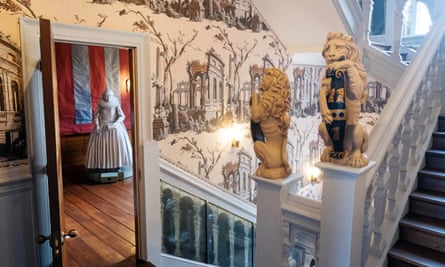A Jacobean manor house that has been home to a primary school, an institute for training domestic servants and bedsit accommodation for spinsters in the past 100 years has undergone a £6m restoration project to restore its architectural and decorative gems.
Boston Manor House in Brentford, west London, has been removed from the national Heritage at Risk register following six years of work by skilled craftspeople based on forensic detective work by historians and specialists to establish period details stretching back 400 years.
The house, set in grounds that are now in the shadow of an elevated section of the M4 motorway, will reopen to the public on 7 July.
Among the treasures on show are an original decorative plaster ceiling featuring exotic creatures and an overmantel depicting a biblical scene in what was the state drawing room. It is one of the finest examples of Jacobean plasterwork to survive intact.
Wallpaper dating from 1757 decorating the main staircase has been retained where it was uncovered in an earlier refurbishment of the building, and digitally re-created during this restoration project. Featuring classical ruins and printed in square sheets rather than rolls, the wallpaper was described by architect Harriet Pillman as “very rare and special”.
The staircase is the original 17th-century structure, with six lions, each holding a coat of arms, sitting on newel posts added in the 1840s.
“This is a gem about which not much was known, so every discovery was really exciting,” said Pillman.
The house was built in 1623 by Lady Mary Reade, who inherited the land on the death of her husband, 40 years her senior. He left the couple’s main residence to his grandchildren from an earlier marriage.
She remarried – this time a man 19 years her junior – but Boston Manor House was sold after her death to the Clitherow family, in whose ownership it remained for more than 250 years.
The Clitherows were “architectural magpies”, according to John Collins, historic houses manager at the London borough of Hounslow, and added a stone portico, extra wings and other features.
But after the first world war, the family put the land, house and its contents up for sale. The contents were auctioned, but there was no buyer for the house or land. It was eventually bought by the local council. The land became a public park, which the M4 sliced through in the 1960s, and a variety of uses were found for the crumbling house.
By 2015, “the house was a mess, with a tree growing inside. It was a now-or-never moment,” said Collins. The National Lottery Heritage Fund provided a grant for the building’s restoration and, with additional funding from other bodies, work began in 2017. Specialist heritage craftspeople, including stonemasons, carpenters and silk weavers, were enlisted for the project.

The auctioneers’ catalogue from the sale of the contents in 1922 was an invaluable help in reproducing the look of key rooms. “The Reubens and Van Dykes and Chippendale furniture have all gone, but we have descriptions,” said Collins. “We’re now trying to track down the objects in the hope of getting some back on loan.”
The Clitherows were wealthy and influential London merchants. The family had invested in the East India Company, and later were friends with King William IV and Queen Adelaide, who visited Boston Manor House.
Collins said that no evidence had so far been found of the family’s links with the slave trade, “but we’re still looking. It would be very surprising if there weren’t dark corners at the very least.”
Boston Manor House opens to the public on 7 July. Admission is free.

